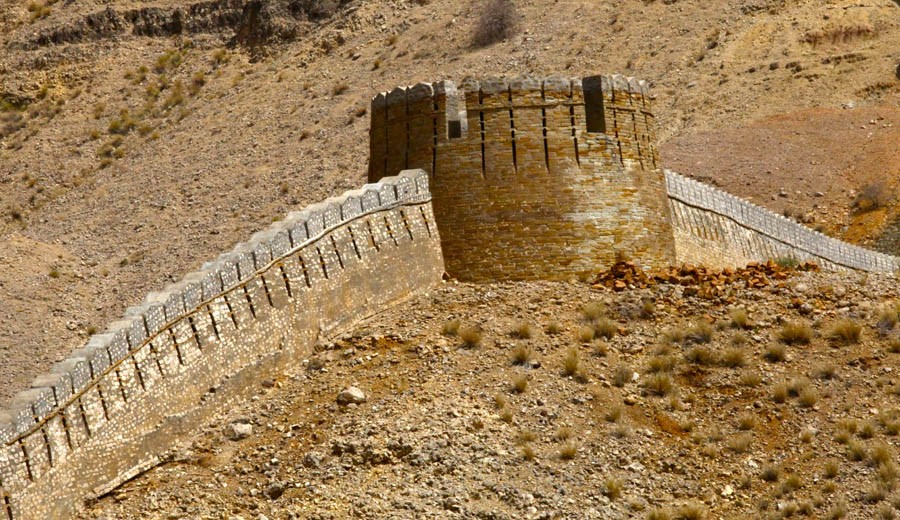
The magnificence of the historical site of Ranikot is hidden under years of neglect

When my dear friend Ali invited me to visit his village in Nawabshah, I jumped at the invitation. Or, let’s say, I accepted it right away. Like many Karachiites, I was oblivious of the rich culture, history and architectural treasures located hours away from the busy city life.
On the National Highway to Dadu, as I was enjoying the sight of wild camels, my car took a slight diversion on a dusty road - and followed the signboard showing "Rani Kot", where a wall snaking through the barren hills caught me by surprise -- "Why is this [the] Wall of China?"
I noticed a striking resemblance between the two walls -- one that lay majestically before me and the one in China, that I saw almost a decade and a half ago. The Great Wall of China is surrounded with greenery and the wall of Ranikot fort with barren hills.
Situated in the Kirthar Mountain Range on the north-western side of Sindh, Ranikot is the largest existing fort in the world.
I didn’t know such a magnificent wonder existed in the midst of wilderness. I blamed lack of promotion of Ranikot as a tourist spot for my ignorance.
Unlike most travellers, I embark on adventures without much reading and researching because I plan my trips last minute and I like my escapades to be full of surprises. So, in a state of bewilderment I, along with my friends Shahrukh and Ali, set out with our cameras mounted with long lenses to explore the fort and its 35km-long fortification wall.
The fort is located in the Kirthar Mountain Range, about 30km southwest of Sann, in Jamshoro District, Sindh. There is no historical record of its architecture so no one knows who built this and what was the purpose. However, it is believed that the fort was built during the regimes of the Sassanians, the Scythians, the Parthians or the Bactrian Greeks. It’s indeed a mystery what exactly the fort protected and from whom. According to the Sindh Gazetteer, some of the present structure was reconstructed by Mir Karam Ali Khan Talpur and his brother Mir Murad Ali in 1812 at a cost of 1.2 million rupees.
Apparently many stories surround the origin and purpose of this fort but not many are documented. So what remains is a structure full of mystique left to us to explore.
The wall, known as the Great Wall of Sindh or the Deware Sindh, runs on three sides of the fort, through hills, valleys and ravines, in a complicated ascending and descending order. The fourth, northern side is protected by the hills. The wall is reinforced with 45 bastions, seven of which are rectangular and the remaining round.
Breathless with climbing, and overwhelmed with the sheer colossal presence of the structure, I could not help thinking who might be the ruling family living in the fort. My mind wandered if there were wars that it braved and enemies it protected from, was it ever conquered and why there are no signs of towns around? With all these random questions, I continued exploring and clicking around. My eyes stopped at the two beautiful niches decorated with floral designs and carved stones located inside the double door gate that lies on the south of the fortress.
Inside the fortification wall are three forts, named Miri Kot, Sher Garh and Mohan Kot, together they make up what is known to be the largest fort of the world. A small fortress, about 5-6 miles inside the main gate, looked like the royal residence for the ruling family. I spent a lot of time looking around the various parts of this fort and was shocked by the abundance of remains from overnight camping and bonfire -- of course these are not to happen at a heritage site like Ranikot.
There are a few beautiful water ponds and streams around the area also. One of them, ‘Paryoun ja Talao’ (Fairy Pond) is deep. I did not take a swim but many villagers were seen taking a dip and enjoying the water on this sunny afternoon.
Compared to other historical architectural sites, this site was not crowded. It was literally abandoned and in severe need of restoration. Since not many tourist or visitors come here, the few odd people walking around from the surrounding villages questioned us about the purpose of our visit, as if they own the fort.
Later in the evening, while sitting at Ali’s haveli at Nawabshah, I came to know that besides a few individuals who organise tours of this area for keen visitors, nothing much is done on the government level to lure tourists.
This is a promising site and has immense potential to be developed as a destination for both local and international travellers.